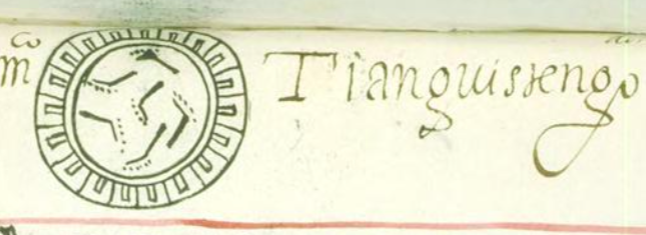Tianquiztenco (Chav5)
This black-line drawing of the compound glyph for the place name Tianquiztenco (“At the Edge of the Market") shows a bird's eye view of a marketplace (tianquiztli, or tianguis in contemporary Spanish). Six footprints pointing various directions suggest people's movement through the tianquiztli and provide the phonetic value of quiza, to emerge, for the -quiz ending. The edge has a patterned border. There is nothing specific to represent the locative suffix (-co), "at," but the perhaps the occupied space is a semantic indicator for the locative.
Stephanie Wood
The top of this tianquiztli glyph is slightly distorted because of its location next to the binding of the manuscript.
Footprint glyphs have a wide range of translations. In this collection, so far, we can attest to yauh, xo, pano, -pan, paina, temo, nemi, quetza, otli, iyaquic hualiloti, huallauh, tepal, tetepotztoca, totoco, otlatoca, -tihui, and the vowel "o." Other research (Herrera et al, 2005, 64) points to additional terms, including: choloa, tlaloa, totoyoa, eco, aci, quiza, maxalihui, centlacxitl, and xocpalli.
Stephanie Wood
Tianguistengo
Tianquiztenco
Stephanie Wood
1578
Stephanie Wood
mercados, markets, tianguis, movimiento, huella, huellas, steps, step, paso, pasos, footprint, footprints, icximachiyotl, xocpalli, icxipamitl, círculos, nombres de lugares

tianquiz(tli), market, or marketplace, https://nahuatl.wired-humanities.org/content/tianquiztli
ten(tli), edge, https://nahuatl.wired-humanities.org/content/tentli
-co (locative suffix), at, https://nahuatl.wired-humanities.org/content/co
A la Orilla del Tianguis
Stephanaie Wood
The Codex Chavero of Huexotzinco (or Códice Chavero de Huexotzinco), https://www.loc.gov/resource/gdcwdl.wdl_03246_001/?sp=5
The Codex Chavero of Huexotzinco (or Códice Chavero de Huexotzinco) is held by the Instituto Nacional de Antropología e Historia, México. It is published online by the World Digital Library and the Library of Congress, which is “unaware of any copyright or other restrictions in the World Digital Library Collection.”






